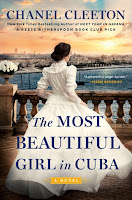Author: Chanel Cleeton
Publication Information: Berkeley. 2021. 384 pages.
ISBN: 0593098870 / 978-0593098875
Book Source: I received this book through NetGalley free of cost in exchange for an honest review.
Opening Sentence: "I am surrounded by forgotten women."
Favorite Quote: "... when you control the media and regulate speech in a country you can shape reality however you see fit."
Next Year in Havana by Chanel Cleeton is based in the history of the 1950s and 1960s and the Castro regime in Cuba. This book travels back to the 1800s - another uprising, another revolution, and another war in the tumultuous history that continues to trace Cuba's existence. This book is set during the time of the Cuban rebellion against Spanish rule. Spain's attempts to squash the rebellion ultimately read to the Spanish-American War.
This book does not travel two timelines like Next Year in Havana. However, it does travel the story to completely different women whose lives intersect in a most unexpected way.
Grace Harrington is a young reporter in New York City. The New York newspaper scene is defined by the rivalry between William Randolph Hearst and Jospeh Pulitzer. The fued for supremacy reigns over everything. Grace finds her a pawn in this feud as she goes to work for The Journal, Hearst's flagship newspaper. As with any reporter, the goal is the next big scoop.
Evangelina Cisneros is an eighteen year old Cuban woman. Because of who she is, what she stands for, and what she attempts, she is ensured in a trap that lands her in a Havana women's jail.
Evangelina Cisneros' story caught William Hearst's attention. In the interest of newspaper supremacy, her story was published in The Journal, with the tag line "The Most Beautiful Girl in Cuba." This, in turn, led to a daring attempt to rescue her from the prison. On October 8, 1897, a New York Times headline read, " Senorita Cisneros Escapes; Bars in her Room in the Casa de Recogidas in Havana Sawed Off and No Clue Found." Subsequently, many raised the question as to whether the whole thing was a hoax or fabricated for newspaper sales. "When you read the news, you don't want to read about every arcane policy disagreement. You want to feel. That's how you win the people."
At an individual character level, this book is the story of Grace Harrington and Evangelina Cisneros, of how their lives intersect, of the escape, and of what comes after. On a broader scale, this is historical fiction about Cuba and about the New York Gilded Age.
On a philosophical level, this story is the conversation about journalism. What is news? How is the news influenced by who brings it to us? How is our reading of the news influenced by what is included and what is left out? What is the impact of a news story on the ones that the news cover? Does the impact of a story to influence change justify the means to get it? Given the current addition of social media and other quasi-entertainment sites as "news" sources, this conversation grows in importance. What is news, and what sources do we trust to bring the factual news to us?
At every level, the book keeps me turning pages until the very end and then, beyond the end, as I research the history to see what happened next.
Please share your thoughts and leave a comment. I would love to "talk" to you.

No comments:
Post a Comment